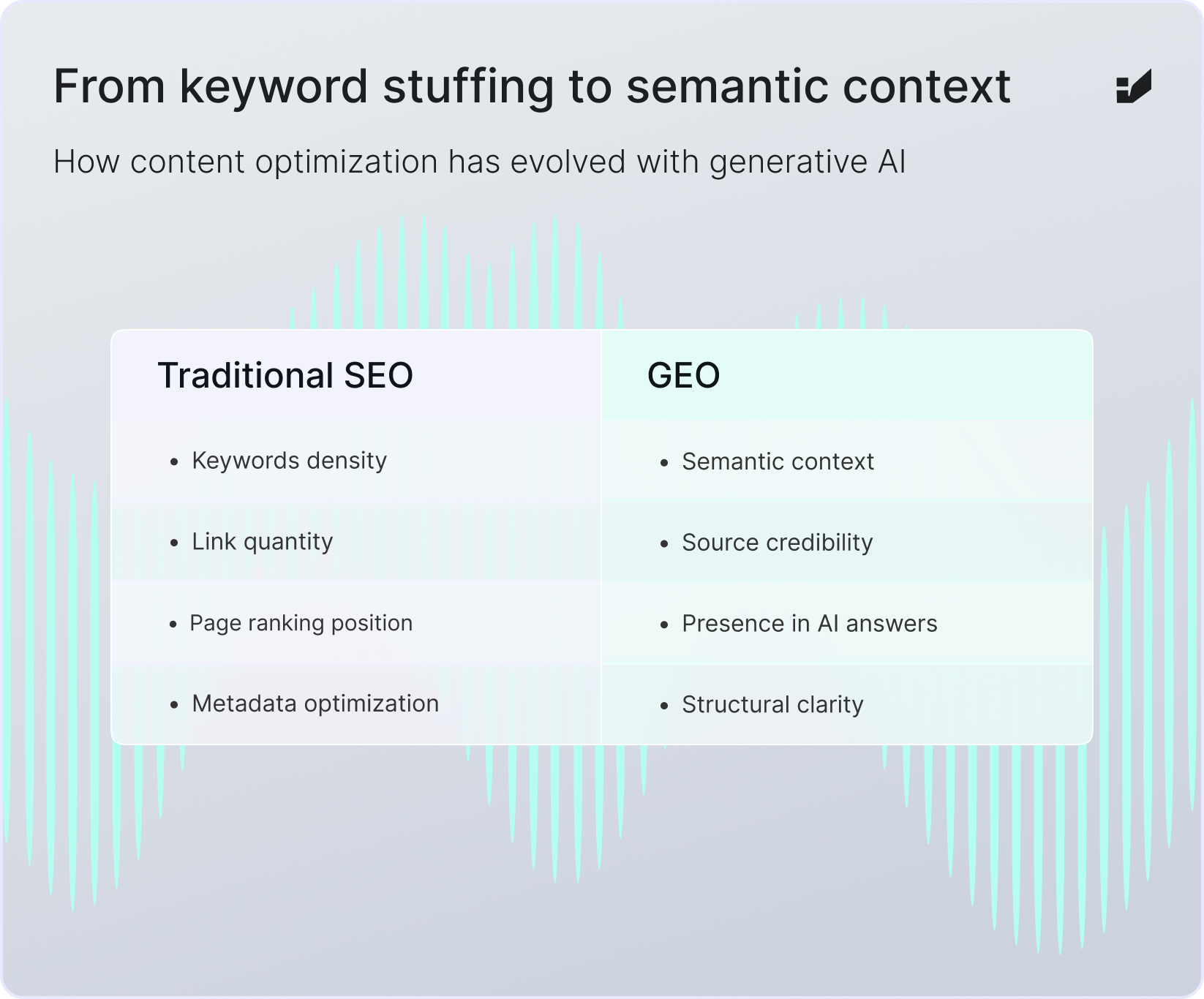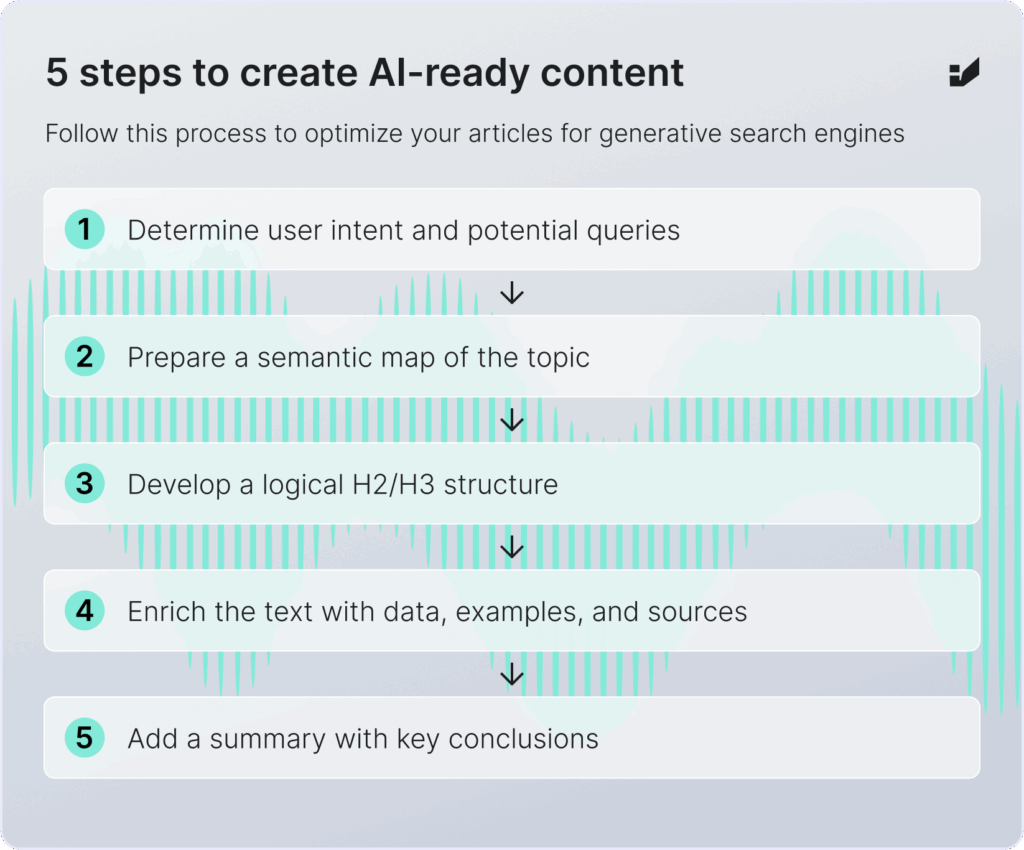Blog articles for AI search engines: how to get noticed?
For years, content optimization focused on keywords, text length, and linking. These elements still matter, but they're no longer enough. Generative search engines like Perplexity, Gemini, or ChatGPT Search have changed the game. These tools don't just search for information - they process it and generate answers on their own.

Traditional SEO is evolving into a new approach: Generative Engine Optimization (GEO). In this strategy, information structure, semantic consistency, and source credibility matter most.
How generative search engines work
Systems based on language models (LLMs) don’t display classic lists of results. Their job is to generate a complete, logical, and substantive answer to the user’s query.
Before using or quoting content, the model analyses numerous sources and selects those that:
- are properly organised and readable
- contain reliable data
- align contextually with the query
- demonstrate expertise and timeliness
Content should be created with how artificial intelligence interprets structure, context, and logical flow in mind.

What is Generative Engine Optimization?
GEO defines content optimization for generative search engines. The goal is to create information that’s easily interpreted, summarized, and cited by language models.
The main principles of GEO include:
- Clarity of structure – an organized layout and logical information flow
- Semantic context – developing the topic through related issues and vocabulary
- Credibility and sources – references to data, studies, and industry reports
- Usefulness – direct answers to users’ questions

Building an AI-friendly article structure
A well-designed content structure helps generative models recognize and use your content. The text should be modular, logically divided, and easy to process.
Introduction
Opening paragraphs must clearly define the purpose and context of the topic. Include data or statistics that justify why the issue matters.
Example: In 2025, over 40% of internet users will use generative search engines as their main source of information.
H2 and H3 headings
Headings should address specific user questions, such as:
- How does a generative search engine work?
- How to create content that an AI system considers valuable?
- What mistakes are made in the GEO optimization process?
Paragraphs and lists
Divide content into short paragraphs and supplement it with bullet points. This formatting increases readability and makes it easier for models to extract key information.
Every few paragraphs, include a summary of the section.
Semantic and contextual optimization
Modern SEO goes beyond repeating keywords. In GEO, creating a network of semantic connections helps AI understand the full scope of your topic.
For the topic “generative search engines,” relevant phrases and related terms include:
- LLM (Large Language Models)
- AI Search / Search Generative Experience (SGE)
- conversational models
- AI SEO
- prompt engineering
Practical recommendations:
- Use natural variants and synonyms of key concepts
- Create internal links between articles on similar topics
- Include numerical data, quotes, and source references
A rich semantic context increases the likelihood that AI will recognize your content as complete and reliable.
E-E-A-T as the foundation of content credibility
The principles of Experience, Expertise, Authoritativeness, and Trustworthiness also apply to generative search engines. Every article should present:
- the author with a short biographical note
- the date of publication and update
- references to external sources and data
- an objective and factual tone
Example of a credibility-building reference: According to a 2024 Gartner report, 70% of corporate content created with AI requires editorial correction to maintain quality standards.
These elements increase the likelihood that a generative model will recognize your content as credible and include it in generated answers.
Writing style that works for AI
In the context of GEO, maintaining a clear and logical writing style is essential. Models prefer texts that are:
- simple in sentence structure
- free of unnecessary embellishments
- containing definitions, data, and examples
Practical recommendations:
- Use the active voice and unambiguous messages
- Avoid excessive adjectives and metaphors
- Add sections like “Key Takeaways” or “In Short” to help the model summarize the content
Keeping content fresh and relevant
In the fast-moving world of artificial intelligence, timeliness matters. Articles should be regularly supplemented with new data and sources.
Recommendations:
- update at least once a year
- maintain the original URL
- include a modification date in the footer or header
These practices increase the value of content for both users and generative models.
The content creation process for GEO
- Determine user intent and potential queries
- Prepare a semantic map of the topic
- Develop a logical H2/H3 structure
- Enrich the text with data, examples, and sources
- Add a summary with key conclusions
Following this process consistently helps you create content that’s both substantive and effective for AI search engines.

The future of content in the AI environment
Generative search engines are changing how users access information. Instead of classic lists of results, a synthesized answer appears – often combining multiple sources. For content creators, this means a different way of competing for user attention.
The traditional SEO goal of ranking position in search results has been replaced by a new success metric: presence in generative answers. Brands and publishers no longer compete for link clicks but for their content to be quoted, paraphrased, or referenced by language models. Visibility no longer depends on placement in SERPs but on the reputation of the source that the algorithm deems most credible and complete.
Expert authority, information structure, and semantic consistency have become even more important. Language models prefer content that is:
- consistently updated
- based on verified data
- clearly formatted and logically structured
- presenting a clear perspective rooted in the author’s or brand’s experience
AI visibility as a new dimension of online presence
AI visibility has become one of the key indicators of content effectiveness in generative search engines. While traditional SEO focused on rankings in search results, AI visibility analyzes how often and in what context a given piece of content is mentioned, summarized, or quoted by language models.
Visibility within the AI ecosystem no longer depends solely on linking or metadata. What truly matters are semantic quality, logical structure, and substantive reputation. Language models choose content based on how accurately it addresses the query’s intent and provides credible information.
AI visibility can be considered a modern equivalent of domain authority – a measure of expertise and trust in the generative era. Publications that consistently provide valuable data and full context are more frequently used as sources in AI-generated answers, directly increasing brand recognition and long-term organic reach.
Building presence in the generative environment requires a strategic approach to content, encompassing both editorial and semantic aspects. Organizations that invest in this area gain higher trust and lasting visibility within the ecosystem of generative answers, which is becoming one of the main channels for knowledge and information distribution online.
Closing notes
Generative Engine Optimization represents the next stage in the evolution of SEO.
Effective blog articles must be:
- logically structured
- contextually complete
- backed by sources
- written in a language understandable to both humans and AI systems
Combining clear structure, credibility, and semantic depth allows you to create content that’s visible in search results and used by generative AI systems as a source of knowledge.


